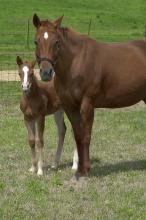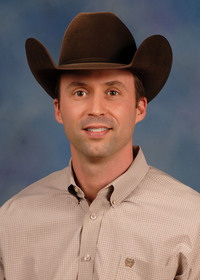Information Possibly Outdated
The information presented on this page was originally released on April 21, 2005. It may not be outdated, but please search our site for more current information. If you plan to quote or reference this information in a publication, please check with the Extension specialist or author before proceeding.
Mare produces three foals in one season
MISSISSIPPI STATE -- The headline, "Mare produces three foals in one season," reads like the front page of a grocery store tabloid, but one Mississippi State University mare actually accomplished this feat in 2005.
Super Mom...
Described by her former owner Buddy Wiggins as a star among cutting horses at the age of 3, Cal Senorita's athletic efforts in the arena resulted in career-ending leg problems. Wiggins donated the American quarter horse with an outstanding pedigree and more than $16,000 in earnings to MSU in 2000.
"I wanted to give MSU the opportunity to improve the quality of its horse herd with a champion like Cal," Wiggins said. "As the daughter of Senorita's Playboy and Cal Gal, I knew she would be a great asset in their breeding program."
Retiring to pasture at the young age of 6 might sound like the easy life for a hard working athlete, but Cal's contributions were not over. She delivered a foal in 2003 that sold for $3,000 in the annual sale to help support the university's livestock program, but her biggest feat came in the spring of 2005. This beautiful, 11-year-old, sorrel-colored mare produced three foals in less than five weeks.
Cal had some help from two pasturemates whose offspring normally would bring less than a third of the price that a foal from a champion like Cal will bring. With the aid of embryo transfer technology, surrogate mothers delivered colts by Cal and two different sires (Blue Bayou Boon and Absolute Acres) on Feb. 12 and Feb. 21 before Cal herself delivered a filly on March 16 by a third sire (Cuttin Touch).
Surrogate mothers...
Cal's offspring are indebted to those surrogate mothers that helped carry the load.
"Foaling is dangerous for mares because they can easily be injured in the process," said Dr. David Christiansen, a clinical instructor in MSU's College of Veterinary Medicine. "Pregnant mares may carry as much as 200 extra pounds, and that can be hard on their bodies."
Christiansen said healthy donors and surrogates are important in the success rate of embryo transfers. He estimated the national success rate to be near 50 percent, but pregnancy rates will be much lower with older or problem mares and higher with young, healthy horses.
"Our surrogates are fully mature, but not old -- usually from 5 to 12 years of age," Christiansen said. "Proven mares that have recently had healthy deliveries are among the best options. Their health is critical for the foal throughout its life."
Dr. Richard Hopper, a professor in MSU's College of Veterinary Medicine and diplomate of the American College of Theriogenologists, said synchronizing the reproductive cycles of both mares improves the environment in the surrogate for the embryo to survive.
"Another benefit is that if the mare does not become pregnant, she will be ready in the subsequent estrus cycle for another attempt," Hopper said. "The fertilized egg needs to be mature enough by day 15 or 16 for the mare's body to recognize the pregnancy and not go back into heat."
Industry benefits...
Suzy Barnett manages Ranche One, a cutting horse farm in Batesville. In the last few years, she has brought six mares to MSU for embryo transfer, including two of her top performers. Both champions -- each with earnings approaching $300,000 -- experienced debilitating injuries that prevented future competition. One was sidelined after two years as a world champion and the other after a career that lasted just seven months.
"Embryo transfer gives us the opportunity to use their genes without endangering the health of the horse, especially when a mare is not capable of carrying a foal full term," Barnett said.
All MSU clients have the option of providing their own surrogate or leasing one of the university's broodmares. Barnett has done both in recent years. When MSU horses served as surrogates, Barnett brought them back to Ranche One until delivery.
"Transferring embryos gives us the opportunity to produce foals using surrogates while the donor mare is still competing. It also enables us to get more than one foal off of a champion in one year," Barnett said. "Up to four foals can be registered from one mare in a single season."
What's in it for us?
Peter Ryan, an animal and dairy science associate professor, said veterinary students as well as undergraduate students benefit from their experiences with the equine reproduction program.
"Embryo transfer is not easy or routine, but it's doable. We have a very good success rate here because the veterinarians work so patiently with the animals," Ryan said. "This is a good teaching opportunity for professors. The students get so much more experience than they would in most other places. That's the biggest value in our equine breeding program."
Many years ago, DVM students may only have had one opportunity to perform a reproductive exam on a mare. Ryan said today's students may do 100 before they graduate.
"Practice builds their skill and confidence level. Because of the increased number of horses, our students get to see more problem cases as well," Ryan said. "This is a win-win-win situation. The students win by seeing and learning from a wide variety of cases; the university wins by having more people involved to help work on a larger number of horses; and the equine industry wins by having access to a facility with lots of experience in reproduction."
Ryan, who holds a joint appointment with the College of Veterinary Medicine, said MSU mares delivered nearly 50 foals in 2004 and should deliver close to that number in 2005.
Contact: Dr. Peter Ryan, (662) 325-2938 or Dr. David Christiansen, (662) 325-1348




